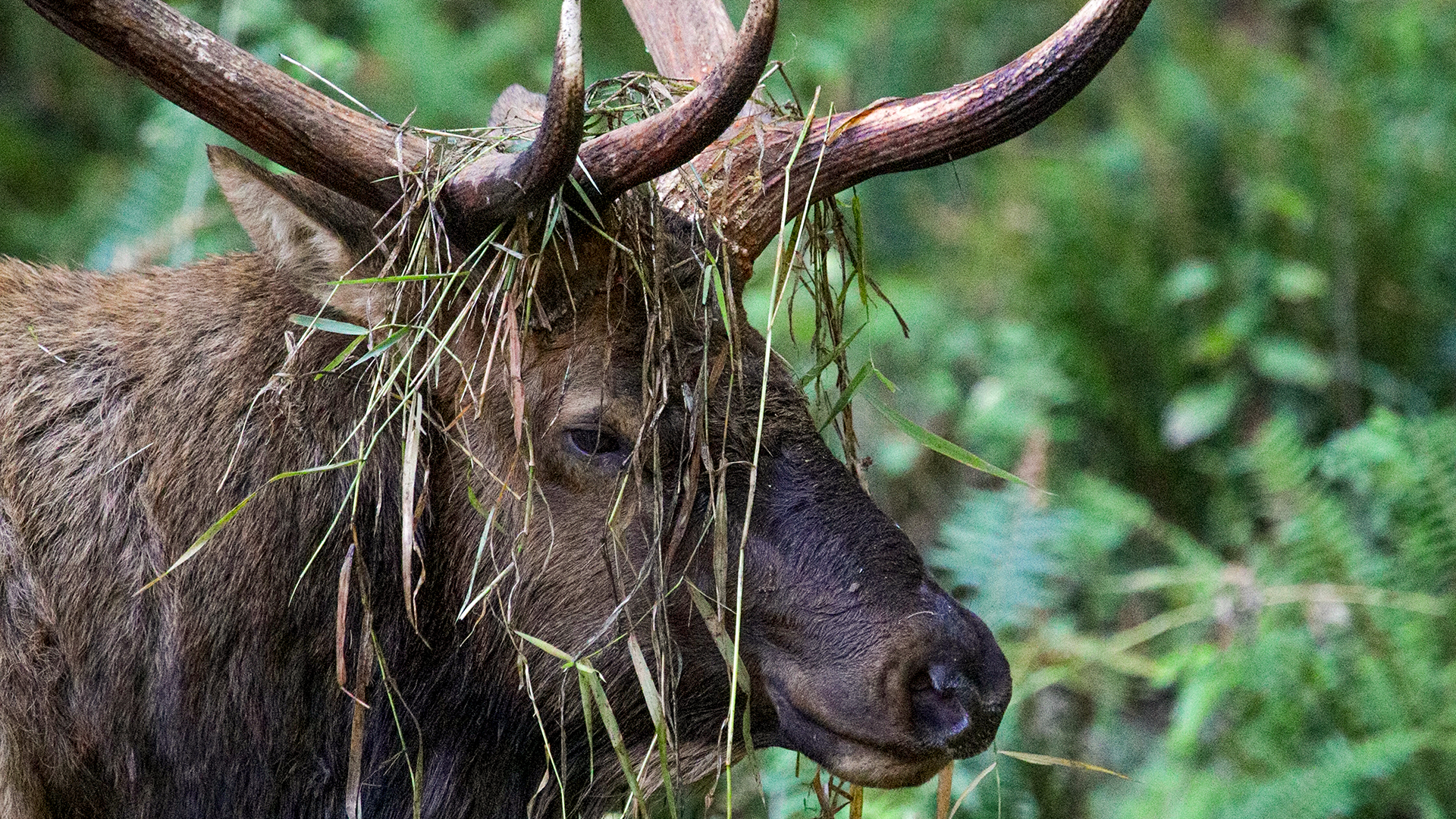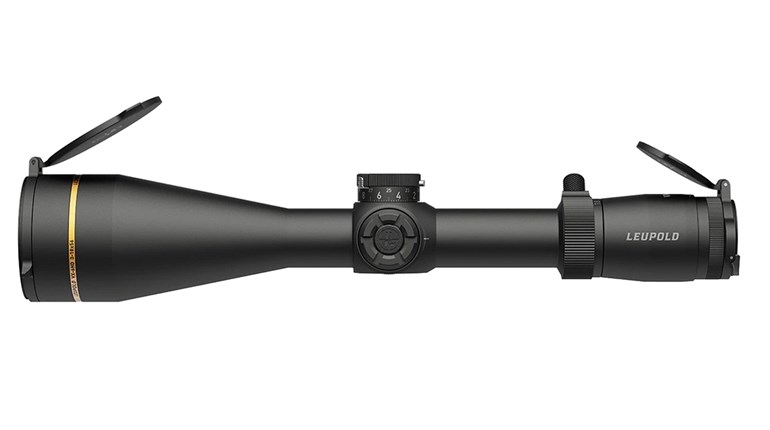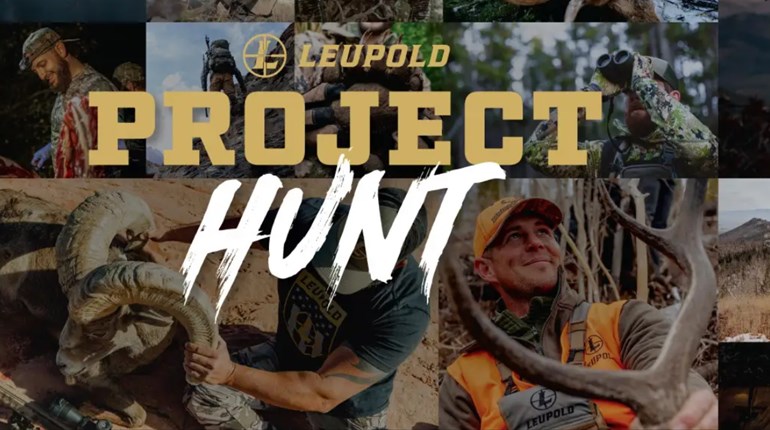
We’d been here before. That much I knew, but only once we’d reached the top did I actually recognize this particular knob. The heavy fog that had blanketed the valley for days prior made it near impossible to learn the terrain, and the well-used ATV trails that crisscrossed this lush coastal conifer woodland seemed to all look the same via my clouded sight picture from the rear seat of the side-by-side. Still, I was starting to recognize certain standout features by the end of the third day traversing those roads, and today, with the sun visible overhead, I was able to see the heavily forested walls of this temperate rainforest corn maze and the turns of two-track ahead. Winding our way through, the rock walls and steep slopes that days prior had been lost to the clouded heavens were now revealed as high cliff points and towering ridges, all descending inward to large hidden tracts of freshly logged clear-cuts and valley floor grass flats. It was in these cuts and grass flats that we’d previously seen their silhouettes, the ghostly apparitions of elk, as we watched from high above through the fog.

Exiting the side-by-side, we shouldered packs and rifles and quickly made our way over the peak to glass the off-side cut. But the elk were 10 steps ahead of us, and when we finally got to where we could see over the top, we were rewarded with flashes of tan and dark brown as they retreated into the thick timber a mere 200 yards down the slope.
We were on the edge of the clear-cut, and scrambling over the remnants of the logging operation turned what was supposed to be a stealthy approach into a cacophony of snapping branches and the faltering footsteps of excited hunters. But though the elk could hear us, we could also hear them making their own ruckus in the dense timber. Knowing we’d been busted, all we could do was halt our forward progress and bring glass to eye, hoping that they’d hold tight just beyond the tree line and give us a chance. Spotting a brown rump of a cow through the trees gave us hope, and perhaps a big bull had stayed with them. The wind was in our favor, so we crouched and glassed, waiting for the elk to calm and hopefully move back out into the clearing.
“Bull,” I whispered, pointing to a dark hole in the timber. “Big bull.” We’d only been glassing for long enough to catch our breath, and though I only caught a quick view of a mature antler with multiple points, I knew it was the one we’d been looking for. What I saw of his body in the shadows was huge, dwarfing his companions, and he was close, less than 150 yards. All I needed now was a bit of luck and a clear shot.
The elk that call this part of western Oregon home are special. Known as the Roosevelt elk, one of four elk subspecies in North America, they are documented to be the largest. Not by rack, necessarily, but by body mass for sure with bulls averaging 700-1,100 pounds. Roosevelt elk, also commonly called Olympic elk (after their native range in Washington state’s Olympic Peninsula) or “Rosies” for short, were named by the famed “father of mammalogy,” Clinton Hart Merriam, in 1897 as a tribute to his good friend and fellow lover of wild lands and animals west of the Mississippi, Theodore Roosevelt.
In an effort to protect the natural habitat of the elk that bore his name, now President Theodore Roosevelt, in 1909, proclaimed a vast part of the Olympic Peninsula a national monument, Mount Olympus. Its more than 1 million acres of prime habitat were later proclaimed Mount Olympus National Park by none other than President Franklin D. Roosevelt in 1938. Today, the range of Rosies stretches from Northern California to southern British Columbia, and they’ve even been introduced on a few islands in Alaska.
Hunting this unique and special elk is a dream come true. I was lucky enough to have a connection to guy who’s been making these kind of elk dreams come true since 1982: Jody Smith. Jody is the owner and operator of Jody Smith Guide Service and offers guided fishing trips for sturgeon, chinook, steelhead and smallmouth bass, as well as guided hunts for mule deer, blacktail deer and Roosevelt elk, the latter two species uniquely inhabiting that small corner of the Pacific Northwest Jody calls home. And let me tell you, Jody is a triple threat: an incredibly knowledgeable big-game guide, one hell of a fisherman and incredibly good company to boot. He currently guides his Rosie clients, both rifle hunters and bowhunters, on private land in southwest Oregon and has a knack for getting them close. Knowing I had a tag to hunt these elk with Jody, I had high hopes and big dreams and became even more excited as the months turned to weeks and the hunt date was on the horizon.

“I just got off the phone with Jody,” said my good friend and industry relations manager of Leupold Optics, Shawn Skipper. “He’s got a few big bulls spotted.” Those words were music to my ears. “He says there’s at least two in the 300 range.” Those words were even better. A giant-bodied Rosie with a 300-class rack is truly something special. And if Jody had seen them, even two weeks before my hunt, they were sure to be around when I got there. These elk don’t migrate like the Rocky Mountain elk. While seasonal temperature swings can push Rockys hundreds of miles in the mountains of Montana and the like, the climate of coastal Oregon is relatively stable, allowing herds of Rosies to find a comfortable valley and stay there year-round. They prefer the old growth timber, and while the logging activities have undoubtedly had an effect on the habitat, when done with elk in mind, the clear-cuts can have a positive effect on the herds, providing grazing areas and dense timber cover in close proximity. Jody’s ground was near perfect.
As I was saying, I’d seen one of those big bulls in the dark timber. I knew he was in there, along with perhaps 20 to 30 of his kin. As we kneeled and glassed a bit longer, it became obvious that the herd wasn’t going far. We could see the occasional cow milling around, and a few smaller bulls flashed racks as they seemed to reorganize in the cover of the thick conifers. Still, they might as well have been a mile out, for as long as they stayed in the cover, they were not going to give us a shot. Even at 200 yards, it was too thick to weave a bullet through, and I think the elk knew it.
We opted to make a move, not a far one, but one that would put us into better position should the elk decide to return to the clearing. We backtracked maybe 40 yards, and then cut farther left, putting us on a knob of a finger that gave a better angle and wider view. It was a waiting game. Hoping for the best, I set out my shooting sticks and placed my Browning rifle atop, resting the butt haphazardly in the crook of my shoulder, enough to stabilize it but allowing me full operational control of my bino at the same time. We were able to confirm the elk were still in the timber, just out of sight, but not out of earshot. Shawn, having a tag of his own, was also ready and waiting.
 One can enter Roosevelt elk country with a tag and visions of a 300-inch bull, but he must pluck success from a landscape usually shrouded in fog.
One can enter Roosevelt elk country with a tag and visions of a 300-inch bull, but he must pluck success from a landscape usually shrouded in fog.
Time ticked on, and with the anticipation running wild, every passing minute felt like 10. A quick glance at my phone to check the time took me by surprise. It was only 8 a.m., but I could have sworn it was getting closer to noon. The sun, high overhead and surrounded by blue skies and sparce whips of white clouds, looked vastly different than the dense fog I had become accustomed to. It was indeed turning out to be a glorious day, and being so early, it was only just the beginning. The beauty of this valley was in full view, and I could almost smell a hint of the Pacific Ocean mixed with the earthy smell of the ancient forest as a cool but warming air rose from the valley floor up and across our faces. Another 30 minutes had passed, and I had all but resigned this stalk, knowing we’d get another chance somewhere across the next distant ridge, when the sounds of milling elk broke the spell, and a single cow emerged from the timber below.
Hesitant, she took one step and then another and dropped her head, plunging her nose into the muck of the clear-cut before lifting it again and looking back toward the timber. Two more cows followed, and I holstered my binocular and placed my hands softly on my rifle. And then it happened. Elk exploded from the timber. Five, 10, 20 and more elk hauled out of that deep woods like a herd of wildebeest, quickly forming a follow-the-leader line out across the clearing. As they dropped down the backside of a small finger ridge we were glassing from and disappeared from view, I swung my rifle to the left in order to catch the train as it galloped up the opposite rise, keeping my head aimed right to watch for the big bull I was sure was about to emerge from the woods. Cows and a few spikes made up the bulk of the herd, with one young raghorn bull in the middle. They snaked their way across the clear-cut, down the near finger and up again, before disappearing over the peak of the next ridge about 100 yards out. I stood at the ready, hoping to see the big bull bringing up the rear.
“Bull, coming at the end,” shouted Shawn in an exited and raised whisper, and I was on him in seconds.
I could tell immediately that he wasn’t the big bull I had seen before, but there were no more elk emerging. He was the last.
“Is that the one we want?” I asked my companions.
“He’s legal,” one of them responded. That wasn’t the answer I was looking for.
“Is that the one we want?” I hurriedly asked again, training my rifle to catch him as he emerged up the next slope.
“Depends on what you want, but someone should shoot him.”
That’s all I needed to hear. I clicked the safety off the rifle as the bull appeared again, 40 yards from the top of the ridge. He must have heard our chatter, because he paused his run and turned broadside to look in our direction. Boom.
The hit was audible, but the bull continued toward the top. In mere seconds he’d be up and over, perhaps gone for good. I worked the bolt fast. Boom. Thwack. Another shot, another hit, just as he reached the peak, and he disappeared over the top.

It’s nice to hunt with friends. Not only do they allow you to shoot first now and again, but when all is said and done they are there to help with the chore of dealing with a downed animal. Shawn was by my side, as he has been for many hunts over many years, and as it turned out the rest of our hunting party had been watching the scene from the valley floor about 500 yards below. We made our way down to them, hoping they’d be able to give some insight into the results of the shooting, and they did. While we’d seen the rest of the herd disappear into the distant valley a few hundred yards away, we weren’t able to discern whether the bull I’d shot was still with them. The group below had seen it all, and they saw the bull go down the off-side of that ridge and never come out again.
As a group we worked our way back up the steep cut and found my bull laying against a clump of logging remnants. After a few minutes of jubilation, we broke out the cameras and got to work capturing the memories of an incredible moment. The bull was huge, by body mass anyway. As for the rack, well, I’d seen bigger that morning, but it didn’t matter, it was still spectacular.
I suppose it depends on the hunter, but for me, the idiom has always held true: A bull in the hand is better than two in timber. Especially when burning such a unique tag is the alternative.
Rigged for Rosies
The Pacific Northwest can be torturous on gear, especially in coastal Oregon. In the off chance it’s not raining, the fog can run so thick as to still drench you and your equipment. It’s imperative that your gear can handle some wet weather.
Starting with my rifle, I was hauling a synthetic-stocked Browning X-Bolt, the Speed SPR model to be exact. And though Browning has since released an updated version in the Browning X-Bolt 2, many of the features of the original Speed SPR I used on this hunt were carried over to the updated model. First, it’s synthetic stock and free-floated match barrel, dual bedded to an incredibly well-built action that lends itself to accuracy. It sports a fast 60-degree bolt throw and a drop-out, flush-fitting rotary magazine. “SPR” stands for “Suppressor Ready,” and I happily topped its 20-inch barrel with one, which greatly reduced the recoil and, along with the quick bolt throw and Browning Feather trigger, allowed me to take an accurate follow-up shot so fast that the group watching from below swore either two shooters were involved or that I was using a semi-auto. I was happy to tell them otherwise.

Praise must also be given to the rifle’s chambering, the 6.8 Western, which is fast becoming a personal favorite. It packs a punch on game, but isn’t one to buck the shoulder. It’s a short-action cartridge, so bolt throw is that much quicker, too. Browning loads the controlled expansion 175-grain Sierra Tipped GameKing bullet in it’s Long Range Pro Hunter ammunition, and I really don’t know of a better suited load. I’ve seen it perform flawlessly on everything from mule deer to cape kudu, and even big-bodied Rosies, penetrating to the offside hide and holding together while doing it. It’s got a muzzle velocity of around 2800 fps, and still retains more than 1,700 ft.-lbs. of shoulder-punching energy at 500 yards. And with a 200-yard zero, it only drops about 7 inches at 300 yards. The 6.8 Western just might be the best of the “new” cartridges, especially in this configuration.
Of course, none of this would be possible without optics, and with a Leupold topping my rifle, as well as riding in my chest harness and topping my tripod, I wouldn’t have the option of blaming the glass if things went south. The 3-18x44mm VX-6HD scope is American-made perfection, with glass that rivals its European counterparts and a price tag that means you can actually afford one. Leupold engineers have spent a lot of time and energy on glass and coatings, making it so clarity isn’t an issue, regardless of time of day and weather conditions. Its 3X-18X zoom range is incredibly versatile, allowing me to have what I needed for a 500-yard poke across the valley, and be ready for the 70-yard shot that my elk offered. Add to that the simplicity of the CDS-ZL2 ZeroLock elevation turret, which was etched with yardage marks to the exact ballistics of my load, and my range and confidence was about maxed out. The system is awesome, allowing me to simply range the target (which was done with the RX-2800 TBR/W), turn the dial to that range and pull the trigger without ever thinking about hold over.
My binocular, a 10x42 BX-5 Santiam HD, has all the clarity and light gathering capabilities of the riflescope, in a rig sized perfectly for all-day carry in a chest harness. While Leupold makes bigger binos, I find the 10x42 to be ideal for 99 percent of my hunting applications, East and West. When I needed to glass farther, the 15-45x65mm SX-4 Pro Guide HD spotting scope provided all the zoom required, and its angled eye cup meant less strain on my neck during glassing sessions longer than a few minutes. It’s easy to use, sports a super smooth focus ring and has all the clarity Leupold is known for. Of course, all my optics came complete with the assurance of Leupold’s unconditional lifetime guarantee. What’s not to love?




































